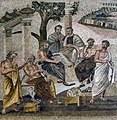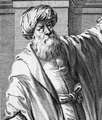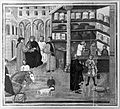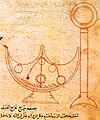Portal:History of science
The History of Science Portal
The history of science covers the development of science from ancient times to the present. It encompasses all three major branches of science: natural, social, and formal. Protoscience, early sciences, and natural philosophies such as alchemy and astrology during the Bronze Age, Iron Age, classical antiquity, and the Middle Ages declined during the early modern period after the establishment of formal disciplines of science in the Age of Enlightenment.
Science's earliest roots can be traced to Ancient Egypt and Mesopotamia around 3000 to 1200 BCE. These civilizations' contributions to mathematics, astronomy, and medicine influenced later Greek natural philosophy of classical antiquity, wherein formal attempts were made to provide explanations of events in the physical world based on natural causes. After the fall of the Western Roman Empire, knowledge of Greek conceptions of the world deteriorated in Latin-speaking Western Europe during the early centuries (400 to 1000 CE) of the Middle Ages, but continued to thrive in the Greek-speaking Byzantine Empire. Aided by translations of Greek texts, the Hellenistic worldview was preserved and absorbed into the Arabic-speaking Muslim world during the Islamic Golden Age. The recovery and assimilation of Greek works and Islamic inquiries into Western Europe from the 10th to 13th century revived the learning of natural philosophy in the West. Traditions of early science were also developed in ancient India and separately in ancient China, the Chinese model having influenced Vietnam, Korea and Japan before Western exploration. Among the Pre-Columbian peoples of Mesoamerica, the Zapotec civilization established their first known traditions of astronomy and mathematics for producing calendars, followed by other civilizations such as the Maya.
Natural philosophy was transformed during the Scientific Revolution in 16th- to 17th-century Europe, as new ideas and discoveries departed from previous Greek conceptions and traditions. The New Science that emerged was more mechanistic in its worldview, more integrated with mathematics, and more reliable and open as its knowledge was based on a newly defined scientific method. More "revolutions" in subsequent centuries soon followed. The chemical revolution of the 18th century, for instance, introduced new quantitative methods and measurements for chemistry. In the 19th century, new perspectives regarding the conservation of energy, age of Earth, and evolution came into focus. And in the 20th century, new discoveries in genetics and physics laid the foundations for new sub disciplines such as molecular biology and particle physics. Moreover, industrial and military concerns as well as the increasing complexity of new research endeavors ushered in the era of "big science," particularly after World War II. (Full article...)
Selected article -

The Einstein–Szilard letter was a letter written by Leo Szilard and signed by Albert Einstein on August 2, 1939, that was sent to President of the United States Franklin D. Roosevelt. Written by Szilard in consultation with fellow Hungarian physicists Edward Teller and Eugene Wigner, the letter warned that Germany might develop atomic bombs and suggested that the United States should start its own nuclear program. It prompted action by Roosevelt, which eventually resulted in the Manhattan Project, the development of the first atomic bombs, and the use of these bombs on the cities of Hiroshima and Nagasaki. (Full article...)
Selected image

"Fuji at Torigoe" is the eightieth woodblock print from One Hundred Views of Mt. Fuji by the Japanese ukiyo-e artist Hokusai. It depicts the observatory of the Calendar Bureau during the Edo period, with astronomers working on the roof, Mount Fuji in the background. According to Hokusai scholar Henry D. Smith II, the instrument is best seen as an indication of Hokusai's interest in Western science rather than a representation of Japanese astronomical practice.
Did you know
...that the word scientist was coined in 1833 by philosopher and historian of science William Whewell?
...that biogeography has its roots in investigations of the story of Noah's Ark?
...that the idea of the "Scientific Revolution" dates only to 1939, with the work of Alexandre Koyré?
Selected Biography -
Claudius Ptolemy (/ˈtɒləmi/; Ancient Greek: Πτολεμαῖος, Ptolemaios; Latin: Claudius Ptolemaeus; c. 100 – c. 170 AD) was an Alexandrian mathematician, astronomer, astrologer, geographer, and music theorist who wrote about a dozen scientific treatises, three of which were important to later Byzantine, Islamic, and Western European science. The first was his astronomical treatise now known as the Almagest, originally entitled Mathematical Treatise (Greek: Μαθηματικὴ Σύνταξις, Mathēmatikḗ Syntaxis). The second is the Geography, which is a thorough discussion on maps and the geographic knowledge of the Greco-Roman world. The third is the astrological treatise in which he attempted to adapt horoscopic astrology to the Aristotelian natural philosophy of his day. This is sometimes known as the Apotelesmatika (Greek: Αποτελεσματικά, lit. 'On the Effects') but more commonly known as the Tetrábiblos, from the Koine Greek meaning "Four Books", or by its Latin equivalent Quadripartite.
The Catholic Church promoted his work, which included the only mathematically sound geocentric model of the Solar System, and unlike most Greek mathematicians, Ptolemy's writings (foremost the Almagest) never ceased to be copied or commented upon, both in late antiquity and in the Middle Ages. However, it is likely that only a few truly mastered the mathematics necessary to understand his works, as evidenced particularly by the many abridged and watered-down introductions to Ptolemy's astronomy that were popular among the Arabs and Byzantines. His work on epicycles has come to symbolize a very complex theoretical model built in order to explain a false assumption. (Full article...)
Selected anniversaries
- 1540 - Birth of Ludolph van Ceulen, German mathematician (d. 1610)
- 1608 - Birth of Giovanni Alfonso Borelli, Italian physiologist and physicist (d. 1679)
- 1611 - Birth of Johannes Hevelius, astronomer (d. 1687)
- 1622 - Birth of Adrien Auzout, French astronomer (d. 1691)
- 1687 - Death of Johannes Hevelius, Polish astronomer (b. 1611)
- 1701 - Birth of Charles Marie de La Condamine, French mathematician and geographer (d. 1774)
- 1724 - The Russian Academy of Sciences was founded in St. Petersburg by Peter the Great, and implemented in the Senate decree. It was called St. Petersburg Academy of Sciences until 1917
- 1855 - The first locomotive runs from the Atlantic Ocean to the Pacific Ocean on the Panama Railway
- 1864 - Birth of Herbert Akroyd Stuart, English engineer - inventor of the first compression ignition engine (d. 1927)
- 1864 - Death of Émile Clapeyron, French engineer and physicist (b. 1799)
- 1884 - Birth of Auguste Piccard, Swiss physicist (d. 1962)
- 1915 - Death of Nikolay Umov, Russian physicist (b. 1846)
- 1922 - Birth of Robert W. Holley, American biochemist, Nobel Laureate (d. 1993)
- 1950 - Death of Nikolai Luzin, Russian mathematician (b. 1883)
Related portals
Topics
General images
Subcategories
Things you can do
Help out by participating in the History of Science Wikiproject (which also coordinates the histories of medicine, technology and philosophy of science) or join the discussion.
Associated Wikimedia
The following Wikimedia Foundation sister projects provide more on this subject:
-
Commons
Free media repository -
Wikibooks
Free textbooks and manuals -
Wikidata
Free knowledge base -
Wikinews
Free-content news -
Wikiquote
Collection of quotations -
Wikisource
Free-content library -
Wikiversity
Free learning tools -
Wiktionary
Dictionary and thesaurus









































































